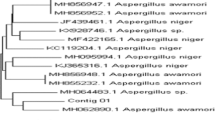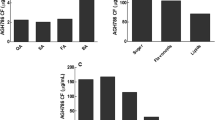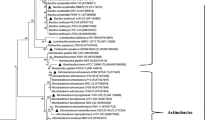Abstract
Little is known about the role of endophytic fungi against abiotic stresses and isoflavonoids (IF) contents of soybean. In current study, we investigated the role of fungal endophytes on the growth of soybean under salt stress conditions. Pure cultures of nine endophytic fungi were isolated from the roots of field-grown soybean plants, and their culture filtrates were screened on Waito-C and Dongjin-byeo rice cultivars; for identification of plant growth promoting fungal strains. It was observed that fungal isolate GMC-2B significantly promoted the growth of both Waito-C and Dongjin-byeo. GMC-2B was later identified as a new strain of Metarhizium anisopliae LHL07 on the basis of 18S rDNA sequences and phylogenetic analysis. Metarhizium anisopliae LHL07 inoculated soybean plants recorded significantly higher shoot length, shoot fresh and dry biomass, chlorophyll contents, transpiration rate, photosynthetic rate and leaf area; under sodium chloride induced salt stress as compared to non-inoculated control plants. An elevated proline and reduced superoxide dismutase and malondialdehyde contents in M. anisopliae LHL07 inoculated soybean plants demonstrated mitigation of salt induced oxidative stress. Furthermore, reduced abscisic acid and elevated jasmonic acid contents in soybean plants confirmed that lesser stress was convened to M. anisopliae inoculated-plants under salinity stress. We also assessed the role of M. anisopliae interaction on IF biosynthesis of soybean, and found significantly higher IF contents in M. anisopliae inoculated soybean plants. In conclusion, endophytic fungal interactions with soybean can be beneficial to improve soybean quality and quantity under salt affected agricultural systems.





Similar content being viewed by others
References
Allen MF, Moore TS, Christensen M (1982) Phytohormone changes in Bouteloua gracilis infected by vesicular-arbuscular mycorrhizae. II. Altered levels of gibberellin-like substances and abscisic acid in the host plant. Can J Bot 60:468–471
Al-Tawaha AM, Seguin P, Smith DL, Beaulieu C (2005) Biotic elicitors as a means of increasing isoflavone concentration of soybean seeds. Ann App Biol 146:303–310
Arnold AE (2008) Endophytic fungi: hidden components of tropical community ecology. In: Carson WP, Schnitzer SA (eds) Tropical forest community ecology. Blackwell Publishing Ltd, West Sussex UK, pp 178–188
Arnold AE, Henk DA, Eells RL, Lutzoni F, Vilgalys R (2007) Diversity and phylogenetic affinities of foliar fungal endophytes in loblolly pine inferred by culturing and environmental PCR. Mycologia 99:185–206
Augé RM (2001) Water relations, drought and vesicular–arbuscular mycorrhizal symbiosis. Mycorrhiza 11:3–42
Bartels D, Sunkar R (2005) Drought and salt tolerance in plants. Crit Rev Plant Sci 24:23–58
Bates LS, Waldren RP, Teare ID (1973) Rapid determination of free proline for water stress studies. Plant Soil 39:205–207
Bohm W (1979) Methods of studying root systems. Berlin, Springer-Verlag, pp 115–124
Catford JG, Staehelin C, Larose G, Piché Y, Vierheilig H (2006) Systemically suppressed isoflavonoids and their stimulating effects on nodulation and mycorrhization in alfalfa split-root systems. Plant Soil 285:257–266
Chandanie WA, Kubota M, Hyakumachi M (2009) Interactions between arbuscular mycorrhizal fungus Glomus mosseae and plant growth-promoting fungi and their significance for enhancing plant growth and suppressing damping-off of cucumber (Cucumis sativus L.). Appl Soil Ecol 41:336–341
Chaves MM, Flexas J, Pinheiro C (2009) Photosynthesis under drought and salt stress: regulation mechanisms from whole plant to cell. Ann Bot 103:551–560
Dakora FD, Phillips DA (1996) Diverse functions of isoflavonoids in legumes transcend anti-microbial definitions of phytoalexins. Physiol Mol Plant Pathol 49:1–20
Dardanelli MS, Manyani H, González-Barroso S, Rodríguez-Carvajal MA, Gil-Serrano AM, Espuny MR, López-Baena FJ, Bellogín RA, Megías M, Ollero FJ (2010) Effect of the presence of the plant growth promoting rhizobacterium (PGPR) Chryseobacterium balustinum Aur9 and salt stress in the pattern of flavonoids exuded by soybean roots. Plant Soil 328:483–493
Dixon RA, Paiva NL (1995) Stress-induced phenylpropanoid metabolism. Plant Cell 7:1085–1097
Gadallah MAA (1999) Effect of proline and glycinebetaine on Vicia faba responses to salt stress. Biol Plantarum 42:247–249
Gamalero E, Berta G, Glick BR (2009) The use of microorganisms to facilitate the growth of plants in saline soils. In: Khan MS et al (eds) Microbial strategies for crop improvement. Springer, Berlin, pp 112–118
Gough C, Galera C, Vasse J, Webster G, Cocking EC, Dénarié J (1997) Specific flavonoids promote intercellular root colonization of Arabidopsis thaliana by Azorhizobium caulinodans ORS571 10. Mol Plant Microb Interact 5:560–570
Hamayun M, Khan SA, Khan AL, Rehman G, Kim YH, Iqbal I, Hussain J, Sohn EY, Lee IJ (2010) Gibberellin production and plant growth promotion from pure cultures of Cladosporium sp. MH-6 isolated from Cucumber (Cucumis sativus. L.). Mycologia 102:989–995
Herrera-Medina MJ, Steinkellner S, Vierheilig H, Bote JAO, Garrido JMG (2007) Abscisic acid determines arbuscule development and functionality in the tomato arbuscular mycorrhiza. New Phytol 175:554–564
Hodges DM, DeLong JM, Forney CF, Prange RK (1999) Improving the thiobarbituric acid-reactive-substances assay for estimating lipid peroxidation in plant tissues containing anthocyanin and other interfering compounds. Planta 207:604–611
Hossain MM, Sultana F, Kubota M, Koyama H, Hyakumachi M (2007) The plant growth-promoting fungus penicillium simplicissimum GP17–2 induces resistance in Arabidopsis thaliana by activation of multiple defense signals. Plant Cell Physiol 48(12):1724–1736
Hussain TM, Chandrasekhar T, Hazara M, Sultan Z, Saleh BK, Gopal GR (2008) Recent advances in salt stress biology–a review. Biotech Mol Biol Rev 3:008–013
Hyde KD, Soytong K (2008) The fungal endophyte dilemma. Fungal Div 33:163–173
Ikeda A, Ueguchi-Tanaka M, Sonoda Y, Kitano H, Koshioka H, Futsuhara Y, Matsuoka M, Yamaguchi J (2001) Slender rice, a constitutive gibberellin response mutant, is caused by a null Mutation of the SLR1 gene, an ortholog of the height-regulating gene GAI/RGA/RHT/D8. Plant Cell 13:999–1010
Iwashina T (2003) Flavonoid function and activity to plants and other organisms. Biol Sci Space 17:24–44
Jahromi F, Aroca R, Porcel R, Ruiz-Lozano JM (2008) Influence of salinity on the in vitro development of Glomus intraradices and on the in vivo physiological and molecular responses of mycorrhizal lettuce plants. Microb Ecol 55:45–53
Jang SW, Hamayun M, Sohn WY, Kang SM, Choi KI, Shin DH, Lee IJ (2008) Growth and gibberellins levels of two rice cultivars as influenced by different Nitrogen containing compounds. J Crop Sci Biotech 11(4):223–226
Khan SA, Hamayun M, Yoon HJ, Kim HY, Suh SJ, Hwang SK et al (2008) Plant growth promotion and Penicillium citrinum. BMC Microbiol 8:231–237
Khan I, Ahmad A, Iqbal M (2009) Modulation of antioxidant defence system for arsenic detoxification in Indian mustard. Ecotox Environ Safe 72:626–634
Khan AL, Hamayun M, Kim YH, Kang SM, Lee IJ (2011) Ameliorative symbiosis of endophyte (Penicillium funiculosum LHL06) under salt stress elevated plant growth of Glycine max L. Plant Physiol Biochem 49:852–862
Khaosaad T, Krenn L, Medjakovic S, Ranner A, Loss A, Nell M, Jungbauer A, Vierheilig H (2008) Effect of mycorrhization on the isoflavone content and the phytoestrogen activity of red clover. J Plant Physiol 165:1161–1167
Kuldau G, Bacon C (2008) Clavicipitaceous endophytes: their ability to enhance resistance of grasses to multiple stresses. Biol Control 46:57–71
Masunaka A, Hyakumachi M, Takenaka S (2011) Plant growth–promoting fungus, Trichoderma koningi suppresses isoflavonoid phytoalexin vestitol production for colonization on/in the roots of Lotus japonica. Microbes Environ 26:128–134
Mauch-Mani B, Mauch F (2005) The role of abscisic acid in plant–pathogen interactions. Curr Opin Plant Biol 8:409–414
McCloud ES, Baldwin IT (1997) Herbivory and caterpillar regurgitants amplify the wound induced increases in jasmonic acid but not nicotine in Nicotiana sylvestris. Planta 203:430–435
Misra N, Gupta AK (2005) Effect of salt stress on proline metabolism in two high yielding genotypes of green gram. Plant Sci 169:331–339
Mittler R (2006) Abiotic stress, the field environment and stress combination. Trends Plant Sci 11:15–19
Moesta P, Grisebach H (1980) Effects of biotic and abiotic elicitors on phytoalexin metabolism in soybean. Nature 286:710–711
Morandi D (1996) Occurrence of phytoalexins and phenolic compounds on endomycorrhizal interactions, and their potential role in biological control. Plant Soil 185:241–251
Munns R, Tester M (2008) Mechanisms of salinity tolerance. Annu Rev Plant Biol 59:651–681
Ohkawa H, Ohishi N, Yagi K (1979) Assay of lipid peroxides in animal tissue by thiobarbituric acid reaction. Anal Biochem 95:351–358
Paranidharan V, Palaniswami A, Vidhyasekaran P, Velazhahan R (2005) A host-specific toxin of Rhizoctonia solani triggers superoxide dismutase (SOD) activity in rice. Arch Phytopath Plant Prot 38(2):151–156
Pathan MS, Lee JD, Shannon JG, Nguyen HT (2007) Recent advances in breeding for drought and salt stress tolerance in soybean. In: Jenks MA, Hasegawa PM, Jain SM (eds) Advances in molecular breeding toward drought and salt tolerant crops. Springer, Netherlands, pp 739–773
Phommalth S, Jeong Y, Kim Y, Dhakal KH, Hwang Y (2008) Effects of light treatment on isoflavone content of germinated soybean seeds. J Agric Food Chem 56:10123–10128
Pinior A, Grunewaldt-Stöcker G, Alten H, Strasser RJ (2005) Mycorrhizal impact on drought stress tolerance of rose plants probed by chlorophyll a fluorescence, proline content and visual scoring. Mycorrhiza 15:596–605
Placer ZA, Cushman LL, Johnson BC (1966) Estimation of product of lipid peroxidation (malonyl dialdehyde) in biochemical systems. Ann Biochem 16:359–364
Porcel R, Ruiz-Lozano JM (2004) Arbuscular mycorrhizal influence on leaf water potential, solute accumulation, and oxidative stress in soybean plants subjected to drought stress. J Exp Bot 55:1743–1750
Qi QG, Rose PA, Abrams GD, Taylor DC, Abrams SR, Cutler AJ (1998) Abscisic acid metabolism, 3-ketoacyl-coenzyme a synthase gene expression and very-long-chain monounsaturated fatty acid biosynthesis in Brassica napus embryos. Plant Physiol 117:979–987
Redman RS, Kim YO, Woodward CJDA, Greer C, Espino L et al (2011) Increased fitness of rice plants to abiotic stress via habitat adapted symbiosis: a strategy for mitigating impacts of climate change. PLoS ONE 6(7):e14823. doi:10.1371/journal.pone.0014823
Richardson AE, Barea J, McNeill AM, Prigent-Combaret C (2009) Acquisition of phosphorus and nitrogen in the rhizosphere and plant growth promotion by microorganisms. Plant Soil 321:305–339
Rincón A, Priha O, Lelu-Walter MA, Bonet M, Sotta B, Tacon F (2005) Shoot water status and ABA responses of transgenic hybrid larch Larix kaempfieri × L. decidua to ectomycorrhizal fungi and osmotic stress. Tree Physiol 25:1101–1108
Sannazzaro AI, Ruiz OA, Albetró EO, Menendez AB (2006) Alleviation of salt stress in lotus glaber by Glomus intraradies. Plant Soil 285:279–287
Schmidt PE, Broughton WJ, Werner D (1994) Nod factors of Bradyrhizobium japonicum and Rhizobium sp. NGR234 induce flavonoid accumulation in soybean root exudates. Mol Plant Microbe Interact 7:384–390
Schulz B, Boyle C (2005) The endophytic continuum. Mycol Res 109:661–686
Sharifi M, Ghorbanli M, Ebrahimzadeh H (2007) Improved growth of salinity-stressed soybean after inoculation with pre-treated mycorrhizal fungi. J Plant Physiol 164:1144–1151
Sharp ER, LeNoble ME, Else MA, Thorne ET, Gherardi F (2000) Endogenous ABA maintains shoot growth in tomato independtly of effects on plant water balance: evidence for an interaction with ethylene. J Exp Bot 51:1575–1584
Shaw LJ, Morris P, Hooker JE (2006) Perception and modification of plant flavonoid signals by rhizosphere microorganisms. Enivon Microbiol 8:1867–1880
Stumpe M, Carsjens JG, Stenzel I, Gobel C, Lang I, Pawlowski K, Hause B, Feussner I (2005) Lipid metabolism in arbuscular mycorrhizal roots of Medicago truncatula. Phytochem 66:781–791
Subramanian S, Stacey G, Yu O (2007) Distinct, crucial roles of flavonoids during legume nodulation. Trends Plant Sci 12:282–285
Sudhir P, Murthy SDS (2004) Effects of salt stress on basic processes of photosynthesis. Photosynthetica 42(4):481–486
Tamura K, Dudley J, Nei M, Kumar S (2007) MEGA4: molecular evolutionary genetics analysis (MEGA) software version 4.0. Mol Biol Evol 24:1596–1599
Tretner C, Huth U, Hause B (2008) Mechanostimulation of Medicago truncatula leads to enhanced levels of jasmonic acid. J Exp Bot 59:2847–2856
Türkan T, Demiral T (2009) Recent developments in understanding salinity tolerance. Environ Exper Bot 67:2–9
Verbruggen N, Hermans C (2008) Proline accumulation in plants: a review. Amino Acids 35:753–759
Volpin H, Elkind Y, Okon Y, Kapulnik Y (1994) A vesicular arbuscular mycorrhizal fungus (Glomus intrarudix) induces a defense response in alfalfa roots. Plant Physiol 104:683–689
Waller F, Achatz B, Baltruschat H, Fodor J, Becker K, Fischer M, Heier T, Huckelhoven R, Neumann C, Von-Wettstein D, Franken P, Kogel KH (2005) The endophytic fungus Piriformis indica reprograms barley to salt-stress tolerance, disease resistance and higher yield. P Natl Acad Sci 102:13386–13391
Wang Y, Mopper S, Hasenstein KH (2001) Effects of salinity on endogenous ABA, IAA, JA, and SA in Iris hexagona. J Chem Eco 27:327–342
Acknowledgments
This research work was supported by Eco-Innovation Project, Korean Government’s R & D program on Environmental Technology & Development and Brain Korea 21 (BK21) Project, Republic of Korea.
Author information
Authors and Affiliations
Corresponding author
Electronic supplementary material
Below is the link to the electronic supplementary material.
Rights and permissions
About this article
Cite this article
Khan, A.L., Hamayun, M., Khan, S.A. et al. Pure culture of Metarhizium anisopliae LHL07 reprograms soybean to higher growth and mitigates salt stress. World J Microbiol Biotechnol 28, 1483–1494 (2012). https://doi.org/10.1007/s11274-011-0950-9
Received:
Accepted:
Published:
Issue Date:
DOI: https://doi.org/10.1007/s11274-011-0950-9




